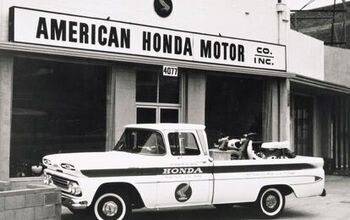Japan's Auto Production Hit By Parts Paralysis

After a long weekend (Monday was Spring Equinox), Japan came back to work today. Most of the Japanese auto industry did not.
Japan’s largest automaker Toyota, and Japan’s third largest, Honda, won’t be making any cars this week. Japan’s auto production is paralyzed.
“TMC has decided that the halt of vehicle production at TMC plants and subsidiary vehicle manufacturers will continue until (and include) March 26 (a scheduled Saturday production day). Meanwhile, TMC resumed production of replacement parts on March 17 and resumed the production of parts for overseas production (including knockdown parts) on March 21.”
Hard hit Honda sent out an even more ominous message:
Japan’s second largest automaker, Nissan, had nothing to announce. They already had said that they would open some plants to make some much needed-parts (there are a lot of cars to be fixed in Japan). On Thursday, Nissan will start assembling vehicles at five factories and will make some cars until the parts run out.
These three cover the bulk of the Japanese car production.
“Other carmakers resumed temporary production — as long as part supplies last,” reports Automotive News.
Mitsubishi is making cars today from parts that had already been made before the disaster, but were stuck due to bad roads. Five or six suppliers of Mitsubishi are out of commission. “As a result, Mitsubishi is suspending production indefinitely from Wednesday,” Automotive News says.
Mazda is up, but probably not for long. There is production of replacement parts and parts for overseas factories. Whatever cars can be built with parts already in stock will be built. Then, the line stops.
Suzuki is trying to finish vehicles already in-process with existing parts and components. It looks like they might run out of those on Thursday.
Subaru has suspended vehicle assembly until at least Thursday.
The message is clear: The Japanese auto industry is cut off from its lifeline, its parts suppliers. Whatever parts can be made in-house are being made. Whatever cars can be produced with existing inventory, are being produced (with the exception of Toyota and Honda). That’s it.
Reuters already coined the term “Japan parts paralysis,” affecting everybody from miners in Brazil to buyers of iPads in Cleveland.
And don’t think it will all be over next week. As the Mainichi Shimbun writes today,
“Suspension of vehicle output is highly likely to last for a long time as the two major Japanese automakers currently have no prospects of resuming production.”
The smaller automakers share the same suppliers and the same bleak prospects.

Bertel Schmitt comes back to journalism after taking a 35 year break in advertising and marketing. He ran and owned advertising agencies in Duesseldorf, Germany, and New York City. Volkswagen A.G. was Bertel's most important corporate account. Schmitt's advertising and marketing career touched many corners of the industry with a special focus on automotive products and services. Since 2004, he lives in Japan and China with his wife <a href="http://www.tomokoandbertel.com"> Tomoko </a>. Bertel Schmitt is a founding board member of the <a href="http://www.offshoresuperseries.com"> Offshore Super Series </a>, an American offshore powerboat racing organization. He is co-owner of the racing team Typhoon.
More by Bertel Schmitt
Latest Car Reviews
Read moreLatest Product Reviews
Read moreRecent Comments
- SCE to AUX Range only matters if you need more of it - just like towing capacity in trucks.I have a short-range EV and still manage to put 1000 miles/month on it, because the car is perfectly suited to my use case.There is no such thing as one-size-fits all with vehicles.
- Doug brockman There will be many many people living in apartments without dedicated charging facilities in future who will need personal vehicles to get to work and school and for whom mass transit will be an annoying inconvenience
- Jeff Self driving cars are not ready for prime time.
- Lichtronamo Watch as the non-us based automakers shift more production to Mexico in the future.
- 28-Cars-Later " Electrek recently dug around in Tesla’s online parts catalog and found that the windshield costs a whopping $1,900 to replace.To be fair, that’s around what a Mercedes S-Class or Rivian windshield costs, but the Tesla’s glass is unique because of its shape. It’s also worth noting that most insurance plans have glass replacement options that can make the repair a low- or zero-cost issue. "Now I understand why my insurance is so high despite no claims for years and about 7,500 annual miles between three cars.


































Comments
Join the conversation
Vernal Equinox - social diseases with... horses? Ok, enough of thread hijacking.
Nothing like a little ungulate humor...